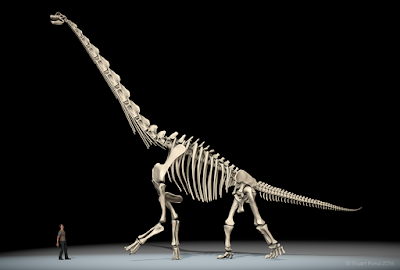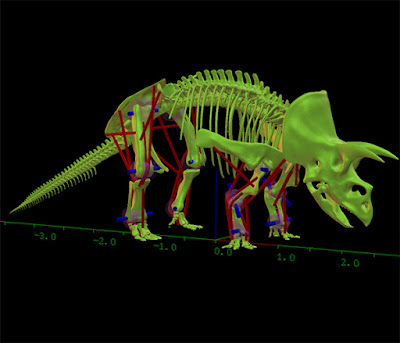Reconstructing fossils digitally has become a vital technique in palaeontology in recent years. The ability to reconstruct the entire skeletons of extinct taxa gives us the opportunity to look at aspects of an organism’s life that would prove difficult or impossible using physical models, for example in biomechanics and gait analysis.
 |
| Er, hi. The final, posed Gorgosaurus model, created in zBrush 4R7 and Cinema 4D R16. |
A recent paper by Stephan Lautenschlager (http://rsos.royalsocietypublishing.org/content/3/10/160342) on digital fossil restoration techniques provides a good overview of the methodology using tools available for digital palaeontology in most labs, including Avizo, Blender and Maya. I highly recommend this paper for anyone interested in the digital restoration of fossil specimens and the workflow involved, much contained in the paper being relevant to the digital reconstruction of specimens for research and outreach.
Last year I worked on a project with Dr. Willam Sellers of Animal Simulation Laboratory (http://www.animalsimulation.org) at the University of Manchester which required the creation of six accurate and complete dinosaur skeletons (see my previous post on the project: http://paleoillustrata.blogspot.co.uk/2016/01/walking-and-making-dinosaur.html), and for this I used a workflow developed in my work creating scientific animations and illustrations for the MedComms industry, a workflow not dissimilar to many commercial studios where 3D assets of all description are produced. axon, the makers of one of the 3D modelling and animation applications I use, Cinema 4D R18, covered this project on their website: https://www.maxon.net/en/industries/visualization/article/everybody-walk-the-dinosaur/
 |
| A specimen (NHM R175) recorded using photogrammetry and suitable for use as a basis for reconstruction of the bone. |
The reference used to create individual elements comes from a number of sources. Primary amongst these are meshes generated using with photogrammetry, Lidar or CT scanning. These data are often received as point clouds that require the generation of a mesh. These datasets can be pretty hefty (especially if they are of entire mounted skeletons or other large, complex subjects) so they require chopping down into manageable chunks prior to meshing to make processing more efficient, for example isolating part of a limb or the skull. I use MeshLab (http://meshlab.sourceforge.net) for this part of the processes, saving sections of the point cloud and meshing them individually. The meshes generated from this procedure are the basis for the reconstruction and these are imported as reference meshes into the main 3D package prior to starting modelling. The literature was consulted and where possible collections were visited and photographs taken to maximise the available reference for modelling. This is important because as there is a fair amount of morphological variation within a particular taxa and this needs to be taken into account when modelling the skeletons, and in fact the final models are composites and don’t represent a single specimen.
Like many studios I use more than one application to create my models of palaeontological specimens. As mentioned earlier, the main 3D application I use for both research and commercial work is Cinema 4D R18 by Maxon (https://www.maxon.net). Within C4D I block out the basic form of the model by generating primitives, extruding polygons and dragging edges and points into approximate position (see this post for how this works: http://paleoillustrata.blogspot.co.uk/2011/09/building-dinosaur-pulling-polygons-and.html). To make these models practical for biomechanical work and 3D printing, so they needed to have as few polygons as possible whilst retaining accuracy. By starting with very simple, blocky shapes it is far easier to keep control of the polygon count as you model and make sure the mesh density is as low as possible for the final model.
 |
| Low resolution, blocked-out skull ready for importing to zBrush for further sculpting (top), and the skull in the process of being modelled at a higher resolution. |
Once the basic shape is modelled in C4D, the meshes (both reference and model are imported into Pixologic zBrush 4R7 (http://pixologic.com), a 3D modelling package that uses sculpting in clay as a metaphor for modelling 3D meshes. Why not continue modelling in Cinema 4D or anther package? Well, zBrush’s tools are intuitive, fast and easy to use (once you’re used to them) and well suited to creating organic shapes. As a modelling tool widely used in the gaming industry zBrush also offers excellent retopologising and mesh decimation tools, which means models can have a low mesh density whilst retaining detail; it produces very ‘clean’ meshes which are perfect for importing into a wide variety of other applications. Once the model is completed the final mesh is imported back into Cinema 4D for positioning and texturing (if required). I cannot recommend zBrush highly enough for organic modelling and anyone creating reconstructions in 3D should take a close look at this package.
 |
| The skull of Gorgosaurus during the modelling process, showing the layout within zBrush 4R7. |
Assembling a skeleton in Cinema 4D is a task made easier by some of the tools that are add-ons to the application and widely used by modellers and animators. Foremost amongst these is the Mograph module, which allows the cloning of a single element and the manipulation of these clones. This is tremendously useful when creating multiple copies of broadly similar elements such as vertebrae. For example, the tail several vertebrae from certain points along the sequence would be modelled and then those in between generated by cloning and these would then be adjusted individually to match the reference.
 |
| The Triceratops skeleton rigged and hot to trot in GaitSym. |
The final model can be exported out as any type of 3D file, with the most useful being .obj and .fbx at present, but anticipate this changing in the future and save in several formats as well as the proprietary format of the modelling applications.
 |
| The Giraffititan model, posed. |
The use of commercial tools such as zBrush is becoming more common for palaeontologists and palaeoartists, and by paying close attention to the structure of production pipelines and workflows of commercial digital studios is something we as palaeontologists should consider, as there is much to learn from their techniques and methods which we can incorporate into our own reconstruction and restoration arsenal of techniques for generating 3D meshes useful or wide variety of research pathways.





